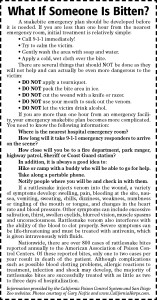REGION — Now that warm weather’s upon us, everyone’s hiking more and more. But watch your step, because you’re not the only one breaking out of a winter rut.
Rattlesnakes are, too.
Each spring, North County sees an increase in rattlesnake near-misses, close calls and bites.
Identifying them seems simple — their eponymous noise can only come from a snake, or a baby — but it’s not a guarantee. Sometimes, the snake doesn’t rattle at all. Think of it as the polar opposite of a kitten’s purr.
Bo Slyapich holds the title of “Rattlesnake Wrangler.” In addition to home and community relocations, he also clears out fields and zones for construction crews and Hollywood productions. Slyapich explained that the unseasonal weather Southern California has been experiencing will affect the frequency, and activity, of the snakes. “Usually with the rain it’s the following year, or the end of the season,” he said. Conversely, the drought we’ve experienced in years prior has affected the population as well. “In the last four years the females have had low numbers,” Slyapich said. “They haven’t been healthy.”
According to Slyapich, the proliferation of rattlesnakes is all a part of a healthy, working ecosystem. “More growth means more seeds, means more rodents, means fat rattlers,” he said. “Mom can have 20-plus kids in late fall, around October or early November. Then they go in hibernation.”
Slyapich refered to the early seasonal surge as a “bumper crop.”
“We’ll see a bumper crop early,” he said. “The babies are smaller, so they warm up first, and that means they come out first.”
Southern California residents should know that snake encounters don’t just happen out on the trails. Homeowners tend to be perplexed when the snakes wind up leaving their dens and infiltrate the suburbs. Slyapich has received several calls where the snake in question has decided to wriggle indoors.
“People have custom doors or people open their doors for the sea breeze,” he said.
Slyapich insisted that there’s a logic to finding a snake in the cupboard: “The thing is, we have water,” he said. “Rodents follow the water, and the snakes follow the grocery store.” Put simply: where there’s snake food, there are snakes.
Tom Derr, who owns and operates a local snake rescue, cautioned that you can even find snakes down to the shore. Once again, the weather is to blame. “You have to be careful,” he said. “Especially after a heavy rain. A lot of the gullies will dump, and if you get a flash flood, it will actually push rattlesnakes out of wherever they are, and take them right out to the beach.”
Rattlesnakes are one of the most feared species of one of the most feared creatures in the entire animal kingdom. Not surprisingly, one of the snakes’ biggest predators is man.
And we can be cruel. One of the methods for rattlesnake prevention and/or disposal is called a “rattlesnake roundup.” These roundups are fairs that happen mostly in Texas and the south. There are funnel cake stands and beer gardens, and everything you’d expect at a town fair, and then there are snakes. Hundreds of them. Ostensibly, visitors bring in snakes they’ve collected and they are sized, weighed and put on display until the main event: public massacring of the snakes.
One of the more troubling aspects is that there’s no science to back up the claim that the snakes are suffering from overpopulation. Rattlesnake roundups represent a senseless, primitive and barbaric disregard for the environment, serving to disrupt local ecosystems at all levels,” Dr. Phillip Arena said. Arena is an independent consultant herpetologist working with the Advocates for Snake Preservation. “With removal of such high numbers of efficient predators, prey animals such as rodents flourish, with the potential to spread disease and which also have a major impact on grain production and storage,” he added. “Rattlesnakes need to be celebrated not decimated and rattlesnake roundups are not the mark of a progressive nation.”
Fortunately, the odds of you coming across a rattlesnake are low — there are only 7,000-8,000 venomous snake bites a year in the U.S. (and that’s all breeds of venomous snakes), and of those bitten, there are only about five deaths. And here’s even better news: with a few simple best-practices — namely, watch where you step and never put your hands where you can’t see them — you can drastically reduce the odds of being bitten.
It’s worth mentioning that, in all their years of wrangling and rescuing, neither Derr nor Slyapich have been bitten.
The San Diego Humane Society offers helpful guidelines for what to do to prevent, and what to do in case of, rattlesnake bites to your beloved pet. From sdhumane.org: “Actively scan the path in front of you always, regardless of where you are.
Rattlesnakes notoriously show up in places other than hiking trails, such as backyards, roadways and residential areas.
Also scan the areas surrounding your path — it’s common for rattlesnakes to nestle in the shrubbery that lines pathways and when threatened, they can lunge up to half their body length.”
Rattlesnakes are alive and well, and now that it’s warmer, they’re awake. The good news is that you’re unlikely to see one, and even less likely to get bitten.
“Remember: they are harmless if you don’t mess with them, if you corner them, they only have one thing to do — they’re gonna protect themselves,” Derr said. “You will never find an aggressive snake anywhere in California.” But if the idea of a rattlesnake wriggling across your path still fills you with heebie-jeebies, common sense will give you an even greater advantage, so you can enjoy the miles and miles of hiking trails San Diego County has to offer.


